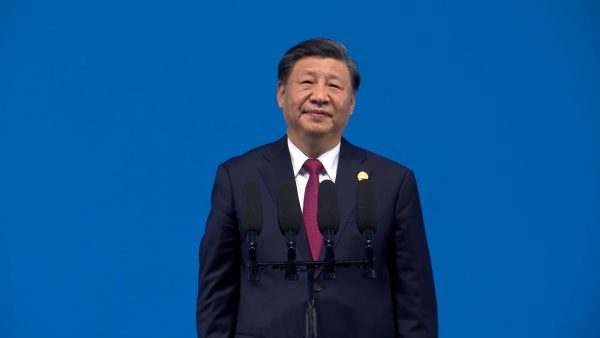Bussiness
Xi’s Rare Symposium With Business Leaders Hints at Third Plenum Agenda
Published
7 months agoon
By
Admin
Beginning on May 22, China’s top leader, Xi Jinping, embarked on an inspection tour of Shandong, China’s third-largest provincial economy. The following day, he presided over a symposium in Jinan, marking the first such convocation of business leaders and experts since late 2020. High-ranking members of the Politburo Standing Committee, including Wang Huning, chairman of the Chinese People’s Political Consultative Conference, and Cai Qi, director of the General Office of the Central Committee, were also in attendance.
Xi’s symposium in Shandong is a critical indicator of the themes and priorities expected to dominate the forthcoming Third Plenum of the Communist Party’s Central Committee, which is scheduled for July. The symposium’s panel featured six business executives from state-owned, private, and multinational enterprises, alongside three prominent economists. This diverse assembly, including high-profile foreign business leaders such as Isabel Ge Mahe from Apple and Yin Zheng from Schneider Electric China, underscored the international dimension of the gathering and signaled an effort to integrate global perspectives into China’s economic policymaking.
According to the Xinhua News Agency, attendees proposed comprehensive reforms, such as deepening electricity system reforms, leveraging technology to upgrade traditional industries, and enhancing the macroeconomic governance framework.
Such high-level engagements between Chinese leadership and business experts are rare; Thursday’s symposium marked only the third instance of its kind since 2018. The inclusion of distinguished neo-Keynesian economists at the recent assembly suggested a possible recalibration of the administration’s strategy: Post-Third Plenum macroeconomic policies might embrace a more proactive approach, departing from the conservative fiscal policies that have defined recent years.
During the symposium, Xi Jinping called for the resolute dismantling of institutional barriers hindering Chinese-style modernization, emphasizing the need for systematic and integrated reforms. He highlighted the importance of addressing critical areas such as employment, income growth, education, healthcare, and housing. Xi urged the implementation of measures that tackle urgent public needs and garner broad support.
Analysts indicate that the most pressing “institutional barriers” to be tackled encompass China’s stringent household registration system and tax-revenue sharing framework. With China’s urbanization rate already elevated, the government may initiate land and household registration reforms following the Third Plenum to invigorate demand. This could potentially involve enabling farmers to trade partial land ownership for urban home purchase rights, thereby reducing housing inventory.
Xi emphasized that the Central Committee conducts thorough research and widely solicits opinions before making major decisions. He assured that suggestions from business and expert representatives would be seriously considered and incorporated. However, the symposium should be seen not merely as a forum for policy input but as a strategic signaling device.
Given the short interval between the symposium and the Third Plenum, it is unlikely that the participants’ suggestions will significantly alter the plenum’s agenda. Instead, the composition of delegates and the issues discussed convey a powerful message to both domestic and international observers. This carefully curated assemblage reflects Beijing’s intent to project a pro-reform, pro-business image amid wavering confidence in China’s economic trajectory.
The timing of the symposium, just ahead of the July plenum, is a calculated move to demonstrate to the international community that China remains open for business. By inviting foreign executives and showcasing their participation, Xi’s administration aims to counteract negative perceptions and reassure global investors of China’s pro-business stance. This deliberate move is designed to project an image of inclusiveness and responsiveness, crucial for attracting and retaining foreign investment amidst economic headwinds.
Additionally, the symposium serves as a deliberate communication to the domestic private sector, affirming the administration’s support and willingness to listen to their concerns. The presence of prominent private business leaders underscores the message that Beijing values their role in the economy and seeks to foster a more favorable business environment. This signaling is vital for boosting domestic business confidence and encouraging investment, key components for sustaining economic growth.
However, it is imperative to temper expectations with a dose of realism. Xi’s administration remains steadfast in its commitment to “Chinese-style modernization,” a model that diverges from Western paradigms by emphasizing state power to bolster industrial capabilities, favoring domestic over foreign enterprises, and prioritizing production over consumption. This approach continues to be a cornerstone of Xi’s economic philosophy.
Market skepticism regarding China’s economic prospects has been simmering for years. Under Xi’s leadership, China has adopted a more security-focused, insular, and authoritarian stance, raising doubts about its commitment to reform. Recent actions, such as raids on foreign consultancies and firms, exacerbate these concerns and erode investor confidence, casting doubt on whether China will sustain the open, reform-oriented policies that underpinned its past economic successes.
Xi’s administration is unlikely to compromise on core political principles or Communist Party leadership. The proposed reforms will focus on enhancing economic efficiency and innovation within the parameters of the existing political framework, thereby ensuring the preservation of political stability and continuity.
A major challenge confronting Xi’s administration is the eroding confidence, particularly evident in the ongoing decline of the property sector despite recent government efforts to rejuvenate it – such as lowering mortgage interest rates and implementing a 300 billion yuan relending facility. These measures have been criticized as “too little, too late.”
Fundamentally, the issue is not a lack of government intervention or its perceived inadequacy. Rebuilding confidence, following years of stringent regulatory crackdowns and the economic downturn induced by COVID-19, will be a prolonged and arduous process. The pervasive lack of trust in Chinese policymakers’ ability to manage a slowing economy is clear, with market participants demanding more substantial policy interventions before reconsidering their bearish stance on the Chinese market, let alone recommitting to it.
Moreover, broader economic and demographic trends further complicate China’s economic prospects. Declining birth rates, an aging population, challenges in transitioning to cleaner energy sources, secular shifts in global supply chains, and international geopolitical tensions present structural headwinds to demand that are unlikely to reverse in the short term. Coupled with the present economic slowdown, these factors suggest that the path to recovery will be long and fraught with difficulties.
Xi Jinping’s Shandong symposium conveys a pro-reform stance, but rhetoric alone will not suffice. Concrete actions and substantial policy shifts are essential to restore confidence in China’s economic trajectory.

Haleon’s Stealth Shopping pop-up hits the streets of NYC

What is the Rams’ clearest path to the playoffs?

Syria not a threat to world, HTS leader Ahmed al-Sharaa tells BBC

Lionsgate Launches Premium Home Entertainment Line

Cancer, Daily Horoscope Today, December 19, 2024: Communication is key – Times of India

How Far Will You Travel for the Right Deal? – Hagerty Media

The Power of Simplicity: Vince Sant’s VShred Journey to Transforming Fitness on Power Athlete Radio

Nintendo Switch 2 Console is Already Predicted to Win the Next Console Generation

YourUpdate TV Speaks with Shipt Seasonal Shopping Expert About Last-Minute Holiday Gifting and Hosting Tips

